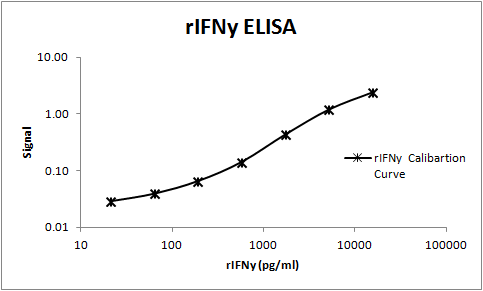Rat IFN-gamma Antibody Summary
Gln23-Cys156
Accession # P01581
Applications
Please Note: Optimal dilutions should be determined by each laboratory for each application. General Protocols are available in the Technical Information section on our website.
Scientific Data
 View Larger
View Larger
IFN‑ gamma Inhibition of EMCV-induced Cytopathy and Neutralization by Rat IFN‑ gamma Antibody. Recombinant Rat IFN-gamma (Catalog # 585-IF) reduces the Encephalomyocarditis Virus (EMCV)-induced cytopathy in the L-929 mouse fibroblast cell line in a dose-dependent manner (orange line). Inhibition of EMCV activity elicited by Recombinant Rat IFN-gamma (2.5 ng/mL) is neutralized (green line) by increasing concentrations of Rat IFN-gamma Monoclonal Antibody (Catalog # MAB585). The ND50 is typically 0.5-1.5 µg/mL.
Reconstitution Calculator
Preparation and Storage
- 12 months from date of receipt, -20 to -70 °C as supplied.
- 1 month, 2 to 8 °C under sterile conditions after reconstitution.
- 6 months, -20 to -70 °C under sterile conditions after reconstitution.
Background: IFN-gamma
Interferon-gamma (IFN-gamma ), also known as type II or immune interferon, exerts a wide range of immunoregulatory activities and is considered to be the prototype proinflammatory cytokine (1, 2). Mature rat IFN-gamma exists as a noncovalently linked homodimer of 20-25 kDa variably glycosylated subunits (3). It shares 86% amino acid sequence identity with mouse IFN-gamma and 37-45% with bovine, canine, cotton rat, equine, feline, human, porcine, and rhesus IFN-gamma. IFN-gamma dimers bind to IFN-gamma RI (alpha subunits) which then interact with IFN-gamma RII (beta subunits) to form the functional receptor complex of two alpha and two beta subunits. Inclusion of IFN-gamma RII increases the binding affinity for ligand and the efficiency of signal transduction (4, 5). IFN-gamma is produced by a variety of immune cells under inflammatory conditions, notably by T cells and NK cells (6). It plays a key role in host defense by promoting the development and activation of Th1 cells, chemoattraction and activation of monocytes and macrophages, upregulation of antigen presentation molecules, and immunoglobulin class switching in B cells. It also exhibits antiviral, antiproliferative, and apoptotic effects (6, 7). In addition, IFN-gamma functions as an anti-inflammatory mediator by promoting the development of regulatory T cells and inhibiting Th17 cell differentiation (8, 9). The pleiotropic effects of IFN-gamma contribute to the development of multiple aspects of atherosclerosis (7).
- Billiau, A. and P. Matthys (2009) Cytokine Growth Factor Rev. 20:97.
- Pestka, S. et al. (2004) Immunol. Rev. 202:8.
- Dijkema, R. et al. (1985) EMBO J. 4:761.
- Marsters, S.A. et al. (1995) Proc. Natl. Acad. Sci. USA 92:5401.
- Krause, C.D. et al. (2000) J. Biol. Chem. 275:22995.
- Schroder, K. et al. (2004) J. Leukoc. Biol. 75:163.
- McLaren, J.E. and D.P. Ramji (2009) Cytokine Growth Factor Rev. 20:125.
- Muhl, H. and J. Pfeilschifter (2003) Int. Immunopharmacol. 3:1247.
- Kelchtermans, H. et al. (2008) Trends Immunol. 29:479.
Product Datasheets
Citations for Rat IFN-gamma Antibody
R&D Systems personnel manually curate a database that contains references using R&D Systems products. The data collected includes not only links to publications in PubMed, but also provides information about sample types, species, and experimental conditions.
2
Citations: Showing 1 - 2
Filter your results:
Filter by:
-
Dental pulp stem cells overexpressing hepatocyte growth factor facilitate the repair of DSS-induced ulcerative colitis
Authors: Ning Li, Yichi Zhang, Narayan Nepal, Guoqing Li, Ningning Yang, Haoyuan Chen et al.
Stem Cell Research & Therapy
-
Differential expression of galanin in the cholinergic basal forebrain of patients with Lewy body disorders
Authors: Athanasios Alexandris, Alan King Lun Liu, Raymond Chuen-Chung Chang, Ronald K. B. Pearce, Steve M. Gentleman
Acta Neuropathologica Communications
FAQs
No product specific FAQs exist for this product, however you may
View all Antibody FAQsReviews for Rat IFN-gamma Antibody
Average Rating: 5 (Based on 1 Review)
Have you used Rat IFN-gamma Antibody?
Submit a review and receive an Amazon gift card.
$25/€18/£15/$25CAN/¥75 Yuan/¥2500 Yen for a review with an image
$10/€7/£6/$10 CAD/¥70 Yuan/¥1110 Yen for a review without an image
Filter by:









